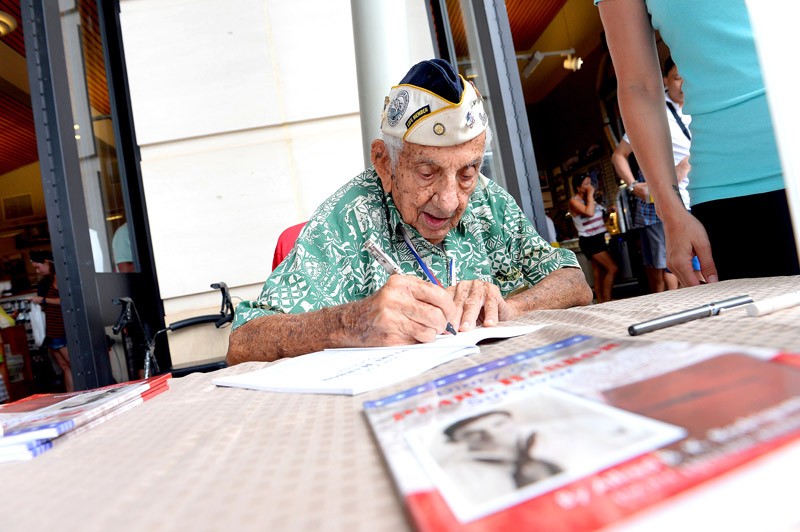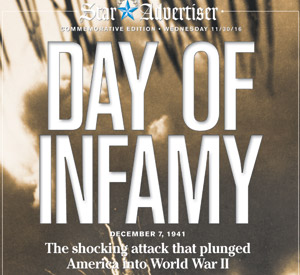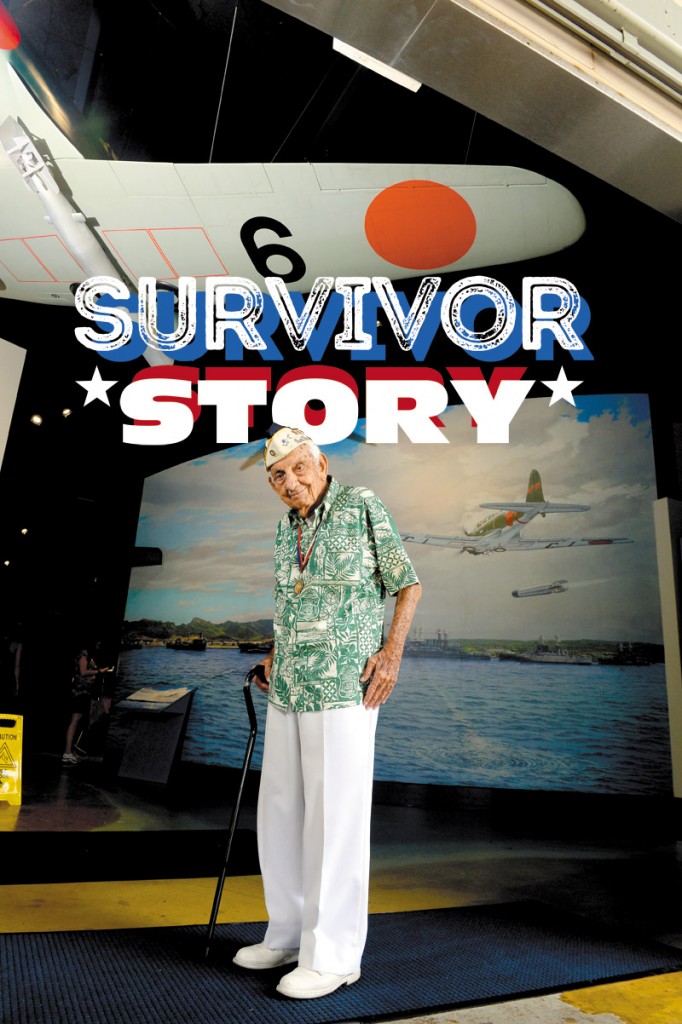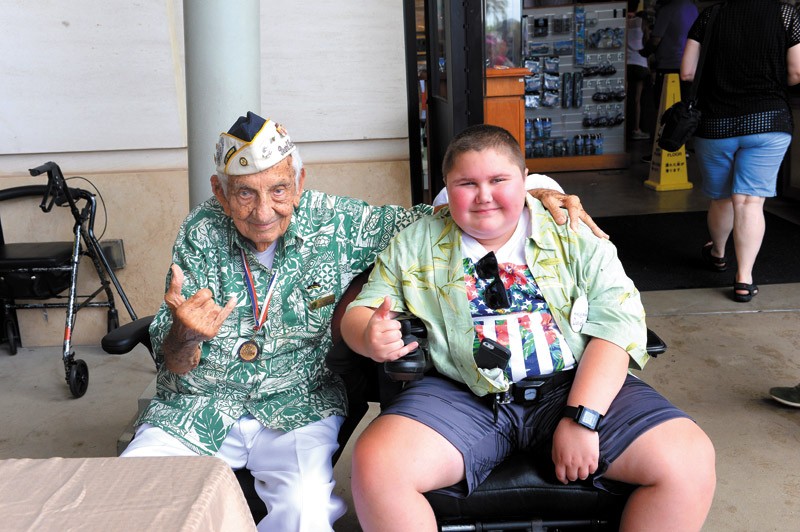Survivor Story
There are those events in our lives that we all remember where we were when we heard the news. We can recall how the sky looked when the towers came down, the smell of the classroom when the Challenger exploded and the look on our mother’s face when the news of the Kennedy assassination came across the airwaves.
They make up the fabric of our lives, the rough part in the stitching we notice whenever we run our hand across it. But, as big a part of our lives as these events remain, to future generations they just will be a part of history, events commemorated in museums and drilled into them in class.
The nation prepares to walk that bridge between collective memory and national history as Pearl Harbor gathers the survivors of that day that shall live in infamy one last time to commemorate the 75th anniversary of the attack on Battleship Row and Oahu as a whole.
“I think, if this was the 74th or 76th anniversary, these veterans would sit it out — to move that far they are just slow and old, and that is a long trip, but they are coming, and they are coming in droves,” says Ray L’Heureux, president and CEO of Pacific Historic Parks. “I think they see this as ‘it’s 75, it is my only opportunity.’ It is going to be moving.”
Airlines — Hawaiian, Alaskan, United and American — all are sponsoring flights to bring the survivors of the events of Dec. 7 and their caretakers out for the nearly fortnight-long remembrances. There will be events all over the island, which L’Heureux hopes will remind us that it was not just Pearl Harbor that was attacked on Dec. 7, 1941.

Pearl Harbor survivor Alfred B.K. Rodrigues signs a book for visitors at Pearl Harbor Visitor Center
“What we are trying to make everyone understand is that it was an attack on Oahu, even though it is Pearl Harbor Day and the USS Arizona gets the attention, there were attacks on Ewa Field, Kaneohe and friendly fire on Americans of Japanese ancestry killed on McCully and King,” says L’Heureux. “The entire island was affected, and we are trying to make sure we tell the whole story this week.”
The remembrances and celebrations will be as varied as the survivors of this historic attack. Military bands from all branches will provide free concerts at the visitor center beginning Dec. 1, culminating Dec. 8-10 with a three-day concert titled “Inspiring the Future,” featuring all-time top-selling recording artist Garth Brooks and wife Tricia Yearwood, with all proceeds going to maintenance of Pacific Historic Parks.
The “Movies on Waikiki Beach” screenings will be filled with films commemorating each armed service branch with Twelve O’Clock High for the Air Force Dec. 2, Run Silent, Run Deep for the Navy Dec. 4, From Here to Eternity for the Army Dec. 5 and The Sands of Iwo Jima for the U.S. Marine Corps Dec. 8.
There will be educational components, as well. The Blackened Canteen Youth Symposium highlights the story of the blackened World War II canteen used by American and Japanese veterans to pour a tribute of bourbon into Pearl Harbor. It commemorates the friendship, honor and reconciliation born out of the horror of WWII. The symposium will address themes of conflict, forgiveness, reconciliation and peacemaking that are reflected in the story of the Blackened Canteen.
They also will roll out new virtual-reality tours Dec. 4 at the visitor center, which will be complimentary on that day.
On the day itself, Dec. 7, the morning ceremony usually held at the visitor center will move to Kilo Pier on base and directly across from the Arizona Memorial. The new location was chosen to accommodate the thousands of people planning to attend, who are expected to include President Obama. There will be free parking at Aloha Stadium and shuttle buses will bring guests to and from the event. Once the 6,000 or so spots available on the pier are filled, the overflow will be welcomed at the visitor center itself, which will have a collection of Jumbotrons to screen the event remotely.
Along with ceremonies at the USS Oklahoma, the Marine Corps base and a parade in Waikiki, perhaps the most stirring moment of the day will involve the double internment of two sailors who survived the attack on the USS Arizona. The Arizona Memorial is the only monument of its kind that allows sailors to return to join their shipmates in their watery grave. This year, John Anderson, boatswain mate 2nd class, and Clarendon Het-rick, seaman 1st class, will be returned to lie beside those 1,102 men who were not so lucky 75 years ago.
There are fewer and fewer of these survivors left, and hearing that story from them one last time before they slip off their mortal coil is the true purpose of this week. The anniversaries will go on, but to hear the story from the men and women who saw it with their own eyes, and can share the firsthand sense of what it was like to see those Japanese Zeros filling the skies with torpedoes and artillery, is an honor, and MidWeek was fortunate enough to get to chat with just one of those souls, Alfred B.K. Rodrigues.
This Kauai boy was born in 1920 and moved to Honolulu after graduating from high school, living the local-boy dream of the time, working at The Royal Hawaiian and surfing the breaks of Waikiki. He did his duty, as mostly all men did in those days, and signed up for the Naval Reserves. He got called up to active duty in November 1940 and was on watch the morning of Dec. 7, when he heard about the USS
Ward dropping depth charges on an as-yet unidentified submarine about a mile out from the harbor entrance.
“I never had breakfast that morning,” says Rodrigues, who spent 24 years in the Navy. “I had the 4-8 watch that morning, so I got up at 3:30, and because it was a humid night, I decided to take a bath. I had just gotten dressed, when we heard some rumblings coming up from the Naval Shipyard. We ignored it because we knew they were dredging the harbor, until the alarm sounded and said, ‘Man your battle stations, this is not a drill.'”
He was issued a .30 caliber rifle, and looked up into the sky and saw the faces of the pilots as they were looking down on the carnage they had wrought. He opened fire.
“We ran out to the armory, and that was when we saw the planes up above with the red circle on the bottom, and we knew it was the Japanese. About two months before it, we had planned for it. They showed us pictures of different countries’ planes, so we knew something was coming, so it was no big surprise. We just accepted it. If it comes, it comes. And it came.”
For years, Rodrigues did not relate this story to anyone. It was a private thing that he held inside, like most of his generation. Then, one day, his son Alfred told him they needed volunteers at Pearl Harbor Visitor Center, and that he should go to share his experiences.
What he found there was an outpouring of emotions from widows, daughters and sons who had lost their loved ones in the war and just needed to someone to talk to, someone who understood and sometimes just someone to hug.
At 96, Rodrigues still volunteers whenever his daughter Aulani can take the time off of work and bring him to the center, and despite his advanced years, he refuses to be photographed sitting down and instead stands with each visitor.
“The first thing people say to me is they are surprised that some of us are still living!” says Rodrigues with a laugh. “But I am serious. You hear a lot of stories from women whose husbands and families were here in Pearl Harbor and it is kind of sad, so I try to talk to them and make them feel pretty good, and I enjoy it.”
Soon these national treasures will be lost to the sands of time. If you only can make one event on this anniversary, perhaps skip the galas and concerts and just come down and shake Rodrigues’ hand and say thanks. For it’s the men and women who fought for us that day who mean the most of all.
For a complete list of events, go to pearlharbor75thanniversary.com

75th Pearl Harbor Commemoration Edition
presented by the Honolulu Star-Advertiser








